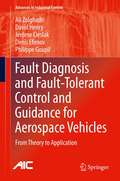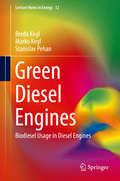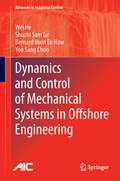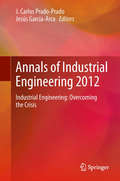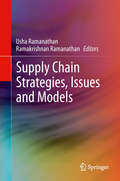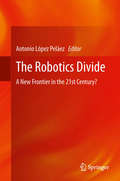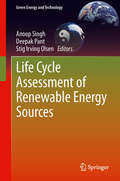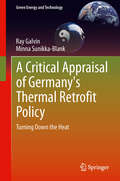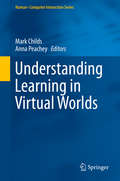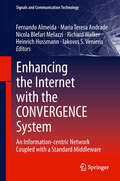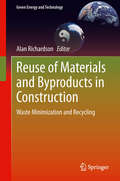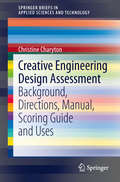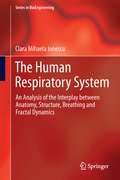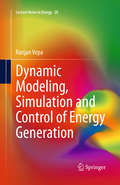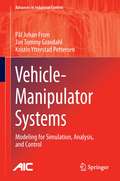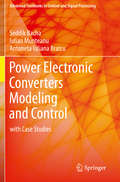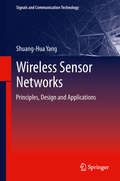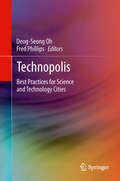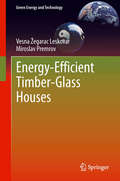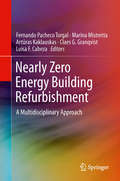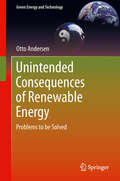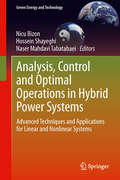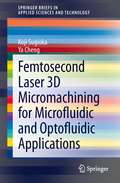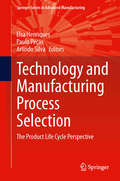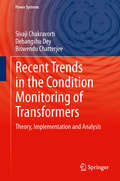- Table View
- List View
Fault Diagnosis and Fault-Tolerant Control and Guidance for Aerospace Vehicles: From Theory to Application (Advances in Industrial Control)
by Ali Zolghadri David Henry Jérôme Cieslak Denis Efimov Philippe GoupilFault Diagnosis and Fault-Tolerant Control and Guidance for Aerospace demonstrates the attractive potential of recent developments in control for resolving such issues as flight performance, self protection and extended-life structures. Importantly, the text deals with a number of practically significant considerations: tuning, complexity of design, real-time capability, evaluation of worst-case performance, robustness in harsh environments, and extensibility when development or adaptation is required. Coverage of such issues helps to draw the advanced concepts arising from academic research back towards the technological concerns of industry. Initial coverage of basic definitions and ideas and a literature review gives way to a treatment of electrical flight control system failures: oscillatory failure, runaway, and jamming. Advanced fault detection and diagnosis for linear and linear-parameter-varying systems are described. Lastly recovery strategies appropriate to remaining actuator/sensor/communications resources are developed. The authors exploit experience gained in research collaboration with academic and major industrial partners to validate advanced fault diagnosis and fault-tolerant control techniques with realistic benchmarks or real-world aeronautical and space systems. Consequently, the results presented in Fault Diagnosis and Fault-Tolerant Control and Guidance for Aerospace, will be of interest in both academic and aerospatial-industrial milieux.
Green Diesel Engines: Biodiesel Usage in Diesel Engines (Lecture Notes in Energy #12)
by Breda Kegl Marko Kegl Stanislav PehanWith a focus on ecology, economy and engine performance, diesel engines are explored in relation to current research and developments. The prevalent trends in this development are outlined with particular focus on the most frequently used alternative fuels in diesel engines; the properties of various type of biodiesel and the concurrent improvement of diesel engine characteristics using numeric optimization alongside current investigation and research work in the field.Following of a short overview of engine control, aftertreatment and alternative fuels, Green Diesel Engine explores the effects of biodiesel usage on injection, fuel spray, combustion, and tribology characteristics, and engine performance. Additionally, optimization procedures of diesel engine characteristics are discussed using practical examples and each topic is corroborated and supported by current research and detailed illustrations.This thorough discussion provides a solid foundation in the current research but also a starting point for fresh ideas for engineers involved in developing/adjusting diesel engines for usage of alternative fuels, researchers in renewable energy, as well as to engineers, advanced undergraduates, and postgraduates.
Dynamics and Control of Mechanical Systems in Offshore Engineering (Advances in Industrial Control)
by Wei He Shuzhi Sam Ge Bernard Voon How Yoo Sang ChooDynamics and Control of Mechanical Systems in Offshore Engineering is a comprehensive treatment of marine mechanical systems (MMS) involved in processes of great importance such as oil drilling and mineral recovery. Ranging from nonlinear dynamic modeling and stability analysis of flexible riser systems, through advanced control design for an installation system with a single rigid payload attached by thrusters, to robust adaptive control for mooring systems, it is an authoritative reference on the dynamics and control of MMS. Readers will gain not only a complete picture of MMS at the system level, but also a better understanding of the technical considerations involved and solutions to problems that commonly arise from dealing with them. The text provides: · a complete framework of dynamical analysis and control design for marine mechanical systems;· new results on the dynamical analysis of riser, mooring and installation systems together with a general modeling method for a class of MMS;· a general method and strategy for realizing the control objectives of marine systems with guaranteed stability the effectiveness of which is illustrated by extensive numerical simulation; and · approximation-based control schemes using neural networks for installation of subsea structures with attached thrusters in the presence of time-varying environmental disturbances and parametric uncertainties.Most of the results presented are analytical with repeatable design algorithms with proven closed-loop stability and performance analysis of the proposed controllers is rigorous and detailed.Dynamics and Control of Mechanical Systems in Offshore Engineering is primarily intended for researchers and engineers in the system and control community, but graduate students studying control and marine engineering will also find it a useful resource as will practitioners working on the design, running or maintenance of offshore platforms.
Annals of Industrial Engineering 2012: Industrial Engineering: overcoming the crisis
by Lorenzo Ros–McDonnell Luis Onieva-GiménezProceedings of the 6th International Conference on Industrial Engineering and Industrial Management and the XVI Congreso de Ingeniería de Organización (CIO 2012). The aim of CIO is to establish a forum for the open and free exchange of ideas, opinions and academic experiences about research, technology transfer or successful business experiences in the field of Industrial Engineering. The CIO 2012 is an annual meeting promoted by “Asociación para el Desarrollo de la Ingeniería de Organización” (Industrial Engineers Association, ADINGOR) with a Scientific Committee composed of 61 international referees and more than 200 professionals from 7 countries. A selection of the lectures and presentations made over three days by researchers and practitioners from different countries are presented here. A range of topics is covered including:A selection of the lectures and presentations made over three days by researchers and practitioners from different countries are presented here. A range of topics is covered including:· Business Administration & Economic Environment · Technological & Organizational Innovation· Logistics & Supply Chain Management· Production & Operations Management· Management Systems & SustainabilityThe conference in Industrial Engineering (CIO) and its proceedings are an excellent platform for the dissemination of the outputs of the scientific projects developed in the frame of the International Research and Development plans.
Supply Chain Strategies, Issues and Models
by Usha Ramanathan Ramakrishnan RamanathanIn the 21st century, supply chain operations and relationships among supply chain partners have become highly challenging, necessitating new approaches, e.g., the development of new models. Supply Chain Strategies, Issues and Models discusses supply chain issues and models with examples from actual industrial cases. Expert authors with a wide spectrum of knowledge working in various areas of supply chain management from various geographical locations offer refreshing, novel and insightful ideas and address possible solutions using established theories and models. Supply Chain Strategies, Issues and Models features studies that have used mathematical modeling, statistical analyses and also descriptive qualitative studies. The chapters cover many relevant themes related to supply chains and logistics including supply chain complexity, information sharing, quality (six sigma), electronic Kanbans, inventory models, scheduling, purchasing and contracts. To facilitate easy reading, the chapters that deal with supply chain related issues are first, followed by studies on inventory, scheduling, purchasing and logistics. This book can be used as a useful resource of supply chain management by academics, students and practitioners. This book can serve as a helping tool in managerial decision making for investments in collaboration and information exchange to improve forecasts, scheduling and inventory management, and for supply chain managers to leverage product and process complexities into competitive advantage. Some interesting mathematical models can appeal to students and researchers interested in modeling the impact of information sharing in supply chains.
The Robotics Divide: A New Frontier in the 21st Century?
by Antonio López PeláezSocieties survive in their environment and compete with each other depending on the technology they develop. Economic, military and political power are directly related to the available technology, while access to technology is key to the well-being of our societies at the individual, community and national level. The Robotics Divide analyzes how robotics will shape our societies in the twenty-first century; a time when industrial and service robotics, particularly for military and aerospace purposes, will become an essential technology. The book, written by experts in the field, focuses on the main technological trends in the field of robotics, and the impact that robotics will have on different facets of social life. By doing so, the authors aim to open the “black box” of a technology which, like any other, is designed, implemented and evaluated according to the economic and cultural patterns of a cosmopolitan society, as well as its relations of power. The Robotics Divide explores future developments in robotics technology and discusses the model of technological development and the implementation of robotics in this competitive market economy. Then the authors examine to what extent it is possible to determine the characteristic features of the robotic divide, namely in what ways the robotic divide differs from the digital divide, and how a model to integrate this technology can be developed without reproducing patterns of inequality and power that have characterized the advent of previous technologies. These issues - inequality, robotics and power - are of concern to robotics and advanced automation engineers, social scientists, economists and science policy experts alike.
Life Cycle Assessment of Renewable Energy Sources (Green Energy and Technology)
by Anoop Singh, Deepak Pant and Stig Irving OlsenGovernments are setting challenging targets to increase the production of energy and transport fuel from sustainable sources. The emphasis is increasingly on renewable sources including wind, solar, geothermal, biomass based biofuel, photovoltaics or energy recovery from waste. What are the environmental consequences of adopting these other sources? How do these various sources compare to each other? Life Cycle Assessment of Renewable Energy Sources tries to answer these questions based on the universally adopted method of Life Cycle Assessment (LCA). This book introduces the concept and importance of LCA in the framework of renewable energy sources and discusses the key issues in conducting their LCA. This is followed by an in-depth discussion of LCA for some of the most common bioenergy sources such as agricultural production systems for biogas and bioethanol, biogas from grass, biodiesel from palm oil, biodiesel from used cooking oil and animal fat, Jatropha biodiesel, lignocellulosic bioethanol, ethanol from cassava and sugarcane molasses, residential photovoltaic systems, wind energy, microalgal biodiesel, biohydrogen and biomethane. Through real examples, the versatility of LCA is well emphasized. Written by experts all over the globe, the book is a cornucopia of information on LCA of bioenergy systems and provides a platform for stimulation of new ideas and thoughts. The book is targeted at practitioners of LCA and will become a useful tool for researchers working on different aspects of bioenergy.
A Critical Appraisal of Germany's Thermal Retrofit Policy: Turning Down the Heat (Green Energy and Technology)
by Ray Galvin Minna Sunikka-BlankGermany is seen as a leader in thermal retrofit policy and practice, but how effective is its approach? A Critical Appraisal of Germany's Thermal Retrofit Policy examines this policy in context and assesses its effectiveness. It finds that technical constraints and the costs of retrofitting reduce the rate of progress, while planning underestimates the influence of user behavior in the form of rebound and prebound effects. A key finding is that savings can be maximized within a policy that understands the actual behavior and motivation of households, the area where most energy savings are already taking place.The book suggests a new policy paradigm that would encourage a better balance of partial and comprehensive retrofits, utilizing household behavior changes based on a better understanding of fuel saving motivation and fuel price elasticity. In this approach, the thermal building regulations would be made more flexible so that policymakers would:- Promote partial, transitional and cost-optimal retrofits, which are more certain to pay back through fuel savings if they are appropriate to building typology and homeowner budgets.- Promote comprehensive retrofits for reasons other than economic gain, focusing instead on the comfort and environmental benefits of energy-efficient homes.- Invest more heavily in educating households to heat economically, learning from the prebound effect so as to maximize the utility of the homes they currently occupy, and base payback time calculations on actual consumption.The results and findings of this book would be of interest to policymakers, researchers and graduate students alike.
Understanding Learning in Virtual Worlds (Human–Computer Interaction Series)
by Mark Childs and Anna PeacheySince the publication of the companion volume Researching Learning in Virtual Worlds in 2010, there has been a growth not only in the range and number of educational initiatives taking place in virtual worlds, but also in the depth of analysis of the nature of that education. Understanding Learning in Virtual Worlds reflects those changes through a collection of chapters that are extended versions of research presented at the second Researching Learning in Virtual Environments conference (ReLIVE 11), an international conference hosted by the Open University UK.Included in this book are chapters that explore the philosophical and methodological underpinnings of understanding learning in virtual worlds, identify and analyse the factors that support learning in these environments, and present case studies that demonstrate some of the various ways in which virtual worlds can be applied to facilitate learning and teaching. The links between learning in a virtual world and learning in the physical world are made apparent throughout, and the authors reveal how understanding learning in one informs the other. Understanding Learning in Virtual Worlds is an important book not only to those who teach in virtual worlds, but to anyone for whom understanding learning, in all its forms, is of interest.
Enhancing the Internet with the CONVERGENCE System: An Information-centric Network Coupled with a Standard Middleware (Signals and Communication Technology)
by Fernando Almeida Maria Teresa Andrade Nicola Blefari Melazzi Richard Walker Heinrich Hussmann Iakovos S. VenierisConvergence proposes the enhancement of the Internet with a novel, content-centric, publish–subscribe service model based on the versatile digital item (VDI): a common container for all kinds of digital content, including digital representations of real-world resources. VDIs will serve the needs of the future Internet, providing a homogeneous method for handling structured information, incorporating security and privacy mechanisms. CONVERGENCE subsumes the following areas of research:· definition of the VDI as a new fundamental unit of distribution and transaction;· content-centric networking functionality to complement or replace IP-address-based routing;· security and privacy protection mechanisms;· open-source middleware, including a community dictionary service to enable rich semantic searches;· applications, tested under real-life conditions.This book shows how CONVERGENCE allows publishing, searching and subscribing to any content. Creators can publish their content by wrapping it and its descriptions into a VDI, setting rights for other users to access this content, monitor its use, and communicate with people using it; they may even update or revoke content previously published. Access to content is more efficient, as search engines exploit VDI metadata for indexing, and the network uses the content name to ensure users always access the copy closest to them. Every node in the network is a content cache; handover is easy; multicast is natural; peer-to-peer is built-in; time/space-decoupling is possible. Application developers can exploit CONVERGENCE’s middleware and network without having to resort to proprietary/ad hoc solutions for common/supporting functionality. Operators can use the network more efficiently, better controlling information transfer and related revenues flows. Network design, operation and management are simplified by integrating diverse functions and avoiding patches and stopgap solutions.Whether as a text for graduate students working on the future of the Internet, or a resource for practitioners providing e-commerce or multimedia services, or scientists defining new technologies, CONVERGENCE will make a valuable contribution to the future shape of the Internet.
Reuse of Materials and Byproducts in Construction: Waste Minimization and Recycling (Green Energy and Technology)
by Alan RichardsonThe construction industry is the largest single waste producing industry in the UK. Ensuring a supply chain of recycled materials affords many potential gains, achieved through: reducing the material volume transported to already over-burdened landfill sites, possible cost reductions to the contractor/client when considering the landfill tax saved and the potential for lower cost material replacements, a reduction in the environmental impact of quarrying and the saving of depleting natural material resources. Reuse of Materials and Byproducts in Construction: Waste Minimization and Recycling addresses use of waste and by products in the construction industry. An over view of new “green” design guides to encourage best practice will be examined and current legislation that channels on site practices, such as site waste management plans. Fundamental individual construction materials are discussed and the process of reforming by products and waste products into new construction materials is investigated, examining the material performance, energy required to convert waste into new products and viability of recycling. The main range of constructional materials will be examined. Aimed at postgraduate students, lecturers and researchers in construction and civil engineering, the book will also be of interest to professional design practices.
Creative Engineering Design Assessment: Background, Directions, Manual, Scoring Guide and Uses (SpringerBriefs in Applied Sciences and Technology)
by Christine CharytonThe Creative Engineering Design Assessment or CEDA is a newly developed tool to assess creativity specific to engineering design which is vital for innovation. The revised CEDA assesses usefulness in addition to originality. Both originality and usefulness are key constructs in creativity but are primarily essential and emphasized ever more in engineering design. Since the preliminary research was presented to the National Science Foundation, further reliability and validity has been developed and established. The CEDA is different from other general creativity measures as it demonstrates discriminant validity with the Creative Personality Scale, Creative Temperament Scale, and the Cognitive Risk Tolerance Scale, and has demonstrated convergent validity with the Purdue Creativity Test and the Purdue Spatial Visualization Test- Rotations. It focuses on engineering specific measures, measuring engineering creativity and spatial skills.The aim of this book is to disseminate the CEDA tool for use in engineering educational programs, industry, NASA and the military. Creative Engineering Design Assessment (CEDA) Background, Directions, Manual, Scoring Guide and Uses discusses and outlines the need for creativity in our global economy and in engineering design and provides the CEDA tool in effort to achieve this.
The Human Respiratory System: An Analysis of the Interplay between Anatomy, Structure, Breathing and Fractal Dynamics (Series in BioEngineering)
by Clara Mihaela IonescuThe Human Respiratory System combines emerging ideas from biology and mathematics to show the reader how to produce models for the development of biomedical engineering applications associated with the lungs and airways. Mathematically mature but in its infancy as far as engineering uses are concerned, fractional calculus is the basis of the methods chosen for system analysis and modelling. This reflects two decades’ worth of conceptual development which is now suitable for bringing to bear in biomedical engineering.The text reveals the latest trends in modelling and identification of human respiratory parameters with a view to developing diagnosis and monitoring technologies. Of special interest is the notion of fractal structure which is indicative of the large-scale biological efficiency of the pulmonary system. The related idea of fractal dimension represents the adaptations in fractal structure caused by environmental factors, notably including disease. These basics are linked to model the dynamical patterns of breathing as a whole.The ideas presented in the book are validated using real data generated from healthy subjects and respiratory patients and rest on non-invasive measurement methods.The Human Respiratory System will be of interest to applied mathematicians studying the modelling of biological systems, to clinicians with interests outside the traditional borders of medicine, and to engineers working with technologies of either direct medical significance or for mitigating changes in the respiratory system caused by, for example, high-altitude or deep-sea environments.
Dynamic Modeling, Simulation and Control of Energy Generation (Lecture Notes in Energy #20)
by Ranjan VepaThis book addresses the core issues involved in the dynamic modeling, simulation and control of a selection of energy systems such as gas turbines, wind turbines, fuel cells and batteries. The principles of modeling and control could be applied to other non-convention methods of energy generation such as solar energy and wave energy.A central feature of Dynamic Modeling, Simulation and Control of Energy Generation is that it brings together diverse topics in thermodynamics, fluid mechanics, heat transfer, electro-chemistry, electrical networks and electrical machines and focuses on their applications in the field of energy generation, its control and regulation. This book will help the reader understand the methods of modelling energy systems for controller design application as well as gain a basic understanding of the processes involved in the design of control systems and regulators. It will also be a useful guide to simulation of the dynamics of energy systems and for implementing monitoring systems based on the estimation of internal system variables from measurements of observable system variables.Dynamic Modeling, Simulation and Control of Energy Generation will serve as a useful aid to designers of hybrid power generating systems involving advanced technology systems such as floating or offshore wind turbines and fuel cells. The book introduces case studies of the practical control laws for a variety of energy generation systems based on nonlinear dynamic models without relying on linearization. Also the book introduces the reader to the use nonlinear model based estimation techniques and their application to energy systems.
Vehicle-Manipulator Systems: Modeling for Simulation, Analysis, and Control (Advances in Industrial Control)
by Pål Johan From Jan Tommy Gravdahl Kristin Ytterstad PettersenFurthering the aim of reducing human exposure to hazardous environments, this monograph presents a detailed study of the modeling and control of vehicle-manipulator systems. The text shows how complex interactions can be performed at remote locations using systems that combine the manipulability of robotic manipulators with the ability of mobile robots to locomote over large areas. The first part studies the kinematics and dynamics of rigid bodies and standard robotic manipulators and can be used as an introduction to robotics focussing on robust mathematical modeling. The monograph then moves on to study vehicle-manipulator systems in great detail with emphasis on combining two different configuration spaces in a mathematically sound way. Robustness of these systems is extremely important and Modeling and Control of Vehicle-manipulator Systems effectively represents the dynamic equations using a mathematically robust framework. Several tools from Lie theory and differential geometry are used to obtain globally valid representations of the dynamic equations of vehicle-manipulator systems. The specific characteristics of several different types of vehicle-manipulator systems are included and the various application areas of these systems are discussed in detail. For underwater robots buoyancy and gravity, drag forces, added mass properties, and ocean currents are considered. For space robotics the effects of free fall environments and the strong dynamic coupling between the spacecraft and the manipulator are discussed. For wheeled robots wheel kinematics and non-holonomic motion is treated, and finally the inertial forces are included for robots mounted on a forced moving base. Modeling and Control of Vehicle-manipulator Systems will be of interest to researchers and engineers studying and working on many applications of robotics: underwater, space, personal assistance, and mobile manipulation in general, all of which have similarities in the equations required for modeling and control.
Power Electronic Converters Modeling and Control: with Case Studies (Advanced Textbooks in Control and Signal Processing)
by Seddik Bacha Iulian Munteanu Antoneta Iuliana BratcuModern power electronic converters are involved in a very broad spectrum of applications: switched-mode power supplies, electrical-machine-motion-control, active power filters, distributed power generation, flexible AC transmission systems, renewable energy conversion systems and vehicular technology, among them.Power Electronics Converters Modeling and Control teaches the reader how to analyze and model the behavior of converters and so to improve their design and control. Dealing with a set of confirmed algorithms specifically developed for use with power converters, this text is in two parts: models and control methods. The first is a detailed exposition of the most usual power converter models:· switched and averaged models;· small/large-signal models; and· time/frequency models.The second focuses on three groups of control methods:· linear control approaches normally associated with power converters;· resonant controllers because of their significance in grid-connected applications; and· nonlinear control methods including feedback linearization, stabilizing, passivity-based, and variable-structure control.Extensive case-study illustration and end-of-chapter exercises reinforce the study material.Power Electronics Converters Modeling and Control addresses the needs of graduate students interested in power electronics, providing a balanced understanding of theoretical ideas coupled with pragmatic tools based on control engineering practice in the field. Academics teaching power electronics will find this an attractive course text and the practical points make the book useful for self tuition by engineers and other practitioners wishing to bring their knowledge up to date.
Wireless Sensor Networks: Principles, Design and Applications (Signals and Communication Technology)
by Shuang-Hua YangWireless Sensor Networks presents the latest practical solutions to the design issues presented in wireless-sensor-network-based systems. Novel features of the text, distributed throughout, include workable solutions, demonstration systems and case studies of the design and application of wireless sensor networks (WSNs) based on the first-hand research and development experience of the author, and the chapters on real applications: building fire safety protection; smart home automation; and logistics resource management. Case studies and applications illustrate the practical perspectives of:· sensor node design;· embedded software design;· routing algorithms;· sink node positioning;· co-existence with other wireless systems;· data fusion;· security;· indoor location tracking;· integrating with radio-frequency identification; and· Internet of thingsWireless Sensor Networks brings together multiple strands of research in the design of WSNs, mainly from software engineering, electronic engineering, and wireless communication perspectives, into an over-arching examination of the subject, benefiting students, field engineers, system developers and IT professionals. The contents have been well used as the teaching material of a course taught at postgraduate level in several universities making it suitable as an advanced text book and a reference book for final-year undergraduate and postgraduate students.
Technopolis: Best Practices for Science and Technology Cities
by Deog-Seong Oh Fred PhillipsSix years of UNESCO-World Technopolis Association workshops, held at various world cities and attended by government officials and scholars from nearly all the world’s countries, have resulted in a uniquely complete collection of reports on science park and science city projects in most of those countries. These reports, of which a selected few form chapters in this book, allow readers to compare knowledge-based development strategies, practices, and successes across countries. The chapters illustrate varying levels of cooperation across government, industry, and academic sectors in the respective projects – and the reasons and philosophies underlying this variation - and resulting differences in practices and results.
Energy-Efficient Timber-Glass Houses (Green Energy and Technology)
by Vesna Žegarac Leskovar Miroslav PremrovThe book discusses combining timber and glass, two eco materials, with a view to developing an optimal contemporary energy-efficient house with an attractive design. Furthermore, the book connects an architectural design approach with structural research to show the possibilities of stabilizing the building with an increased size of the glazing. Research results where the glazing is considered as a load-bearing structural element are therefore presented in a manner leading to the development of an optimal model of the timber-glass house, considering both the structural and energy related aspects. The presented research work can be useful to designers and future experts in their planning of optimal energy-efficient timber buildings. The study is based on using timber and glass, which were previously neglected as construction materials. With suitable technological development and appropriate use, they are nowadays becoming essential construction materials as far as energy efficiency is concerned. However, their combined use is extremely complicated, from both the constructional point of view as well as from that of energy efficiency and sets multiple traps for designers. A good knowledge of their advantages and drawbacks is thus vitally important, which is shown in the present monograph.Energy-efficient timber-glass houses was selected by the Slovenian National Research Agency as an extraordinary scientific achievement in the field of technical sciences/civil engineering for the year 2013.
Nearly Zero Energy Building Refurbishment: A Multidisciplinary Approach
by Fernando Pacheco Torgal, Marina Mistretta, Artūras Kaklauskas, Claes G. Granqvist and Luisa F. CabezaThe recast of the Energy Performance of Buildings Directive (EPBD) was adopted by the European Parliament and the Council of the European Union on 19 May 2010. For new buildings, the recast fixes 2020 as the deadline for all new buildings to be “nearly zero energy” (and even sooner for public buildings – by the end of 2018). This book gives practitioner an important tool to tackle the challenges of building refurbishment towards nearly zero energy.This book is welcome at this time and sets the scene for professionals whether practitioners or researchers to learn more about how we can make whether old or new buildings more efficient and effective in terms of energy performance.
Unintended Consequences of Renewable Energy: Problems to be Solved (Green Energy and Technology)
by Otto AndersenEnergy technologies in the future will need to be based on renewable sources of energy and will, ultimately, need to be sustainable. This book provides insight into unintended, negative impacts and how they can be avoided. In order to steer away from the pitfalls and unintended effects, it is essential that the necessary knowledge is available to the developers and decision makers engaged in renewable energy. The value of this book lies in its presentation of the unintended health and environmental impacts from renewable energies. The book presents results from cross-disciplinary research on the implementation of alternative fuels in the transport sector, namely hydrogen, electricity and biodiesel. This is followed by an assessment of environmental impacts from the production of solar cells. Critical reviews on the use of nanotechnology and nanomaterials in the energy technologies is then provided, with the formation of nanoparticles during combustion of bio-blended diesel and their toxic effects, discussed in detail.
Analysis, Control and Optimal Operations in Hybrid Power Systems: Advanced Techniques and Applications for Linear and Nonlinear Systems (Green Energy and Technology)
by Nicu Bizon, Hossein Shayeghi and Naser Mahdavi TabatabaeiThe book’s text focuses on explaining and analyzing the dynamic performance of linear and nonlinear systems, in particular for Power Systems (PS) including Hybrid Power Sources (HPS). The system stability is important for both PS operation and planning. Placing emphasis on understanding the underlying stability principles, the book opens with an exploration of basic concepts using mathematical models and case studies from linear and nonlinear system, and continues with complex models and algorithms from field of PS. The book’s features include: (1) progressive approach from simplicity to complexity, (2) deeper look into advanced aspects of stability theory, (3) detailed description of system stability using state space energy conservation principle, (4) review of some research in the field of PS stability analysis, (5) advanced models and algorithms for Transmission Network Expansion Planning (TNEP), (6) Stability enhancement including the use of Power System Stabilizer (PSS) and Flexible Alternative Current Transmission Systems (FACTS), and (7) examination of the influence of nonlinear control on fuel cell HPS dynamics.The book will be easy to read and understand and will be an essential resource for both undergraduate and graduate students in electrical engineering as well as to the PhDs and engineers from this field. It is also a clear and comprehensive reference text for undergraduate students, postgraduate and research students studying power systems, and also for practicing engineers and researchers who are working in electricity companies or in the development of power system technologies. All will appreciate the authors' accessible approach in introduction the power system dynamics and stability from both a mathematical and engineering viewpoint.
Femtosecond Laser 3D Micromachining for Microfluidic and Optofluidic Applications (SpringerBriefs in Applied Sciences and Technology)
by Koji Sugioka Ya ChengFemtosecond lasers opened up new avenue in materials processing due to its unique features of ultrashort pulse width and extremely high peak intensity. One of the most important features of femtosecond laser processing is that strong absorption can be induced even by materials which are transparent to the femtosecond laser beam due to nonlinear multiphoton absorption. The multiphoton absorption allows us to perform not only surface but also three-dimensionally internal microfabrication of transparent materials such as glass. This capability makes it possible to directly fabricate three-dimensional microfluidics, micromechanics, microelectronics and microoptics embedded in the glass. Further, these microcomponents can be easily integrated in a single glass microchip by the simple procedure using the femtosecond laser. Thus, the femtosecond laser processing provides some advantages over conventional methods such as traditional semiconductor processing or soft lithography for fabrication of microfluidic, optofludic and lab-on-a-chip devices and thereby many researches on this topic are currently being carried out. This book presents a comprehensive review on the state of the art and future prospects of femtosecond laser processing for fabrication of microfluidics and optofludics including principle of femtosecond laser processing, detailed fabrication procedures of each microcomponent and practical applications to biochemical analysis.
Technology and Manufacturing Process Selection: The Product Life Cycle Perspective (Springer Series in Advanced Manufacturing)
by Elsa Henriques Paulo Pecas Arlindo SilvaThis book provides specific topics intending to contribute to an improved knowledge on Technology Evaluation and Selection in a Life Cycle Perspectives. Although each chapter will present possible approaches and solutions, there are no recipes for success. Each reader will find his/her balance in applying the different topics to his/her own specific situation. Case studies presented throughout will help in deciding what fits best to each situation, but most of all any ultimate success will come out of the interplay between the available solutions and the specific problem or opportunity the reader is faced with.
Recent Trends in the Condition Monitoring of Transformers: Theory, Implementation and Analysis (Power Systems)
by Sivaji Chakravorti Debangshu Dey Biswendu ChatterjeeRecent Trends in the Condition Monitoring of Transformers reflects the current interest in replacing traditional techniques used in power transformer condition monitoring with non-invasive measures such as polarization/depolarization current measurement, recovery voltage measurement, frequency domain spectroscopy and frequency response analysis. The book stresses the importance of scrutinizing the condition of transformer insulation which may fail under present day conditions of intensive use with the resulting degradation of dielectric properties causing functional failure of the transformer.The text shows the reader how to overcome the key challenges facing today’s maintenance policies, namely:The selection of appropriate techniques for dealing with each type of failure process accounting for the needs of plant owners, plant users and wider society; andCost-efficiency and durability of effect.Many of the failure-management methods presented rely on the fact that most failures give warning when they are imminent. These potential failures give rise to identifiable physical conditions and the novel approaches described detect them so that action can be taken to avoid degeneration into full-blown functional failure. This “on-condition” maintenance means that equipment can be left in service as long as a specified set of performance standards continue to be met, avoiding the costly downtime imposed by routine and perhaps unnecessary maintenance but without risking equally expensive failure.Recent Trends in the Condition Monitoring of Transformers will be of considerable interest to both academic researchers in power systems and to engineers working in the power generation and distribution industry showing how new and more efficient methods of fault diagnosis and condition management can increase transformer efficiency and cut costs.
